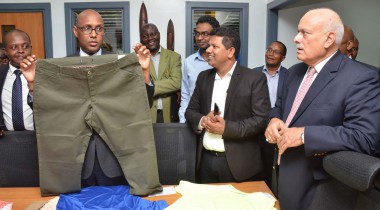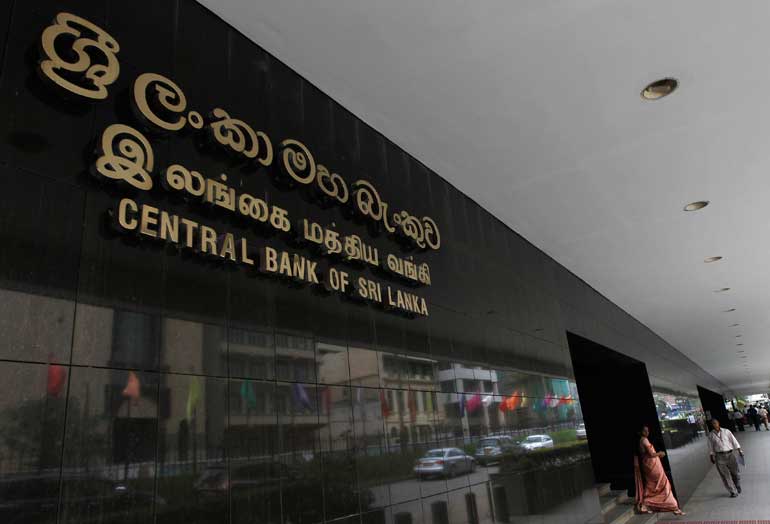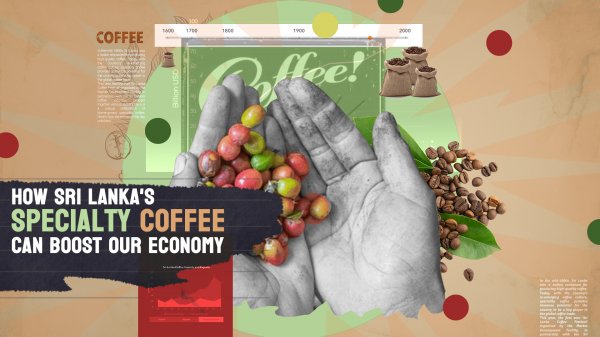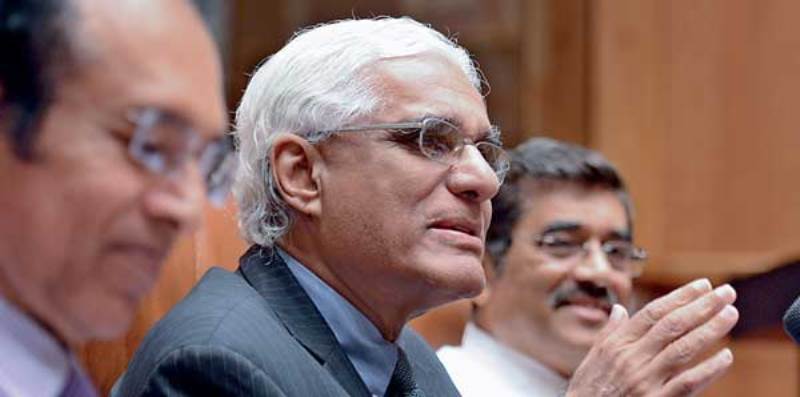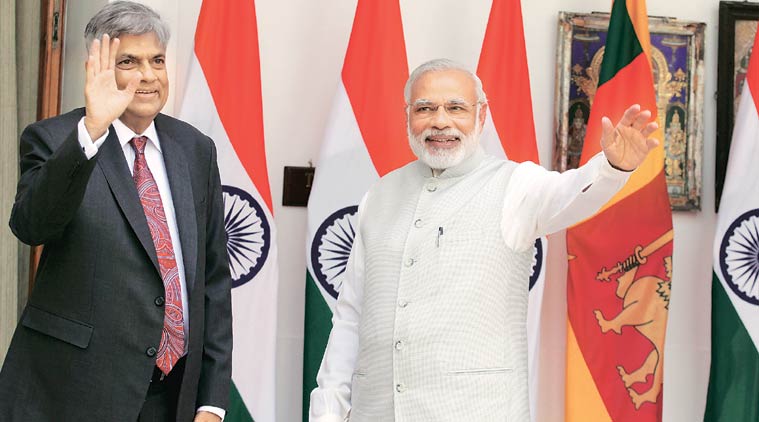
Prime Minister Ranil Wickremesinghe announced earlier this month that the proposed Economic and Technology Cooperation Agreement (ETCA) between India and Sri Lanka will be signed by the end of this year. Following discussions held with his Indian counterpart Narendra Modi, a confident Wickremesinghe said that a mutual decision had been taken to finalise the process over the next two months.
According to the Premier, the agreement will offer a strategic economic advantage to Sri Lanka and what he called the fast-growing southern Indian states of Karnataka, Tamil Nadu, Andhra Pradesh, Kerala, and Telangana.
“These five southern states have a population of 250 million and a combined GDP of USD 450 billion. With an addition of Sri Lanka’s USD 80 billion, the GDP in this sub-regional economy will cross USD 500 billion,” he said, speaking at the Indian Economic Summit held recently in New Delhi.
But exactly how beneficial will it be to Sri Lanka?
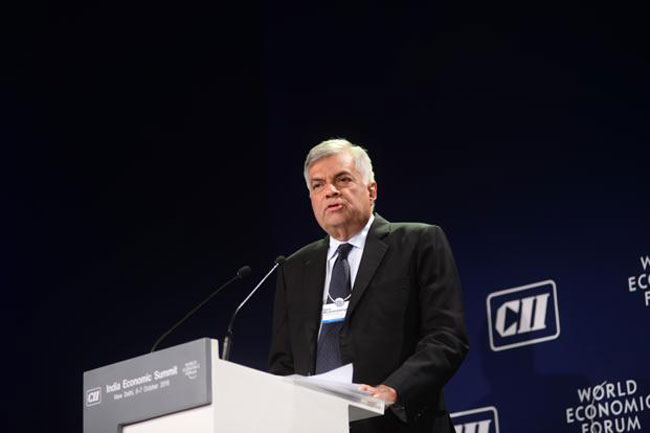
Prime Minister Wickremesinghe speaking at the India Economic Summit. Image courtesy Ada Derana
Background
Sri Lanka already has a free trade agreement (FTA) with India that was signed in 1998 by the then Chandrika Bandaranaike Kumaratunga government. Attempts were made to further liberalise trade in services and investment, which resulted in the formulation of a Comprehensive Economic Partnership Agreement (CEPA) to be signed between the two countries, which ultimately came a cropper in the face of mounting opposition.
The current ETCA, also taking heavy flak from various interest groups including the Government Medical Officers Association (GMOA), ICT professionals as well as opposition political parties such as the Mahinda Rajapaksa faction of the UPFA and the traditionally anti-Indian JVP, is an evolution of the original Indo-Lanka FTA and the CEPA that almost came in its wake; and if the Government has its way, chances are it will materialise sooner rather than later.
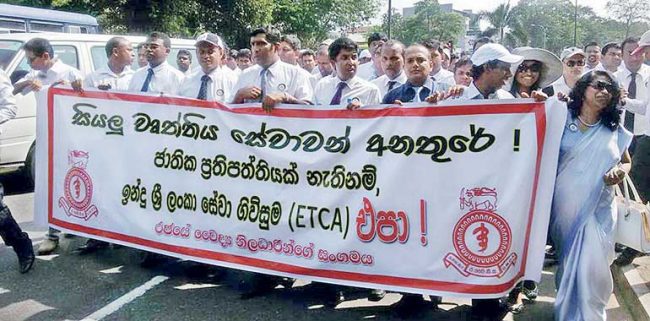
The GMOA has been among the most vociferous of the agreement’s critics. Image courtesy Daily FT
Problems With Existing FTA
There is a prevalent school of thought that the existing FTA between India and Sri Lanka has been largely favourable to India, with Sri Lanka gaining little in comparison. Data from the World Bank appears to back this up.
Indian exports to Sri Lanka as at 2015 was worth USD 4,268 million, whereas Sri Lanka exported only USD 657 million to India.
There is a clear trade deficit between the two countries.
However, according to Subhashini Abeysinghe, Head of Economic Research at Verité Research, this is down to trade competitiveness, with Indian exports being more cost competitive compared to those of Sri Lanka. Sri Lankan products, she said, have recorded sluggish growth in all markets in the world, not just India. Indo-Lanka trade demonstrates the low competitiveness of our exports in general. The country has only a handful of products and the comparative advantage Sri Lanka had in these products (e.g. labour and apparel) is fast deteriorating.
“The problem is far bigger than the FTA. Sri Lanka has not only failed to reap the benefits of the Indo-Lanka FTA, but all other FTAs we have signed thus far as well. The country needs to urgently address constraints faced by the export sector that hamper their competitiveness abroad, if we are to reap the benefits of any FTA we are signing,” she told Roar.
An FTA addresses only part of the competitiveness issues: namely tariffs and non-tariff barriers faced at the border of the importing country. Abeysinghe argues that Sri Lankan exporters face more problems in their home country, starting from the country’s macro economic policies that affect interest rates, exchange rates and inflation, policy inconsistency, and cumbersome and inefficient government processes exporters have to deal with when exporting.
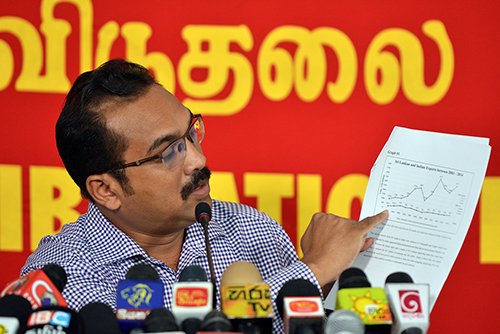
The JVP, too, has been quite vocal about its opposition to the proposed bilateral agreement. – Image courtesy ColomboPage
No Fault of the FTA
Chief Economist at the Ceylon Chamber of Commerce, Anush Wijesinha, who is hesitant to blame the trade deficit on the FTA, believes it’s a fallacy to expect trade between bilateral partners to always balance beautifully or go in Sri Lanka’s favour. While Sri Lanka has a trade deficit with India, it has a massive trade surplus with other countries such as the US and some European nations, he points out.
“It’s more appropriate, from an economic standpoint, to look at it holistically. Let’s look at what is happening to our overall trade (exports plus imports), with all partners. The fact is that overall, Sri Lanka is trading less with the world. We used to be a nation where trade formed close to 90% of GDP. Now it has collapsed to around 55%. Compare this to countries like Thailand, Vietnam, and Malaysia, where the number is above 150%,” he told Roar.
The pro-liberalisation camp has constantly alluded to Indian exports to Sri Lanka being mostly independent of the Indo-Lanka FTA, to explain away the deficit. Wijesinha, too, subscribes to this view. The trade balance with India is mainly driven by imports that are outside of the existing ISFTA such as petroleum products, he points out.
According to Wijesinha, only around 14% of Sri Lankan imports from India are under the FTA, with 94% being outside of it. Meanwhile, over 60% of our exports to India are under the FTA (this was at 20% in the early years of the FTA).
“So the issue with the trade balance with India is not so much the ISFTA, but rather the overall trade volumes. And yes, of course, we must do more to rectify this. But at the end of the day, trade is between firms: Sri Lankan firms exporting to India, Sri Lankan firms importing intermediate inputs from India, etc. A trade agreement can only do so much,” said Wijesinha.
Where ETCA Comes In
Sri Lankan firms also have to seek out new export opportunities to India in competitive product categories catering to the new Indian consumer class. Pointing out that exports to India have plateaued, Wijesinha calls for an update on the existing ISFTA to help reverse this.
“We have to do more to ensure that trade between the two countries is eased up – especially in favour of Sri Lankan exporters. This is where trade facilitation barriers, non-tariff measures, standards recognition, etc., come into play. And this is where some of the sharpest pain points in trading with India exist today. We are told that as part of the ETCA the Sri Lankan side will push for an ‘early harvest’ agreement on these key pain points, and get early commitment from the Indian side to resolve it. We must push for this, as this is the priority. Resolving these can have big benefits for traders on both sides, and increase the overall volume of bilateral trade,” he said.
Wijesinha and other proponents of ETCA argue that the agreement (and its previous incarnation, the CEPA) is important because it is through this new process that Sri Lanka can begin to resolve the outstanding issues with non-tariff barriers, mutual recognition of standards, quota removal, trimming the remaining negative list, etc. (There were certain commodities permitted under the FTA, and a number of commodities that were excluded. This is known as the negative list). Without this new process, they point out, there would be no progress on it.
Are Fears Unfounded?
To say that ETCA has been controversial from the start would be an understatement. Professionals in medical and ICT sectors, in particular, have come out strongly against it, fighting tooth and nail to make sure it doesn’t see the light of day. But is the devil really as black as it is painted?
Well, that depends on whom you ask.
Abeysinghe at Verité says it’s down to two factors: the content of the agreement and the capacity of the country to export.
“The content of the agreement is shaped through stakeholder consultations, research, and skilled negotiations. If these are lacking in any way, the content will fail to deliver benefits. Capacity is related to products/services and their competitiveness, which, as I said before, is a bigger issue that cannot be addressed through an FTA,” she told Roar.
Wijesinha, meanwhile, believes some of the bigger concerns are unfounded, but acknowledges that such fears are to be expected when there are moves to forge deals between a big country and a small one.
“There is a principle of asymmetry in such agreements, where the smaller economy is given more leeway than the larger one. If the agreement is crafted cleverly, it can be mutually-beneficial,” he told Roar.
However, he claimed that “many” in the private sector are optimistic about the new opportunities that deeper trade and investment integration with India can provide, while others are understandably worried. Still others are interested, but unsure or uncertain.
“Each of these groups have their own legitimate reasons for their viewpoint. It depends on their current business and whether they can adapt and compete. It depends on whether they have had, as individual businesses, bad experiences in trading with India. For some others it’s purely ideological and emotional, and not based on fact. So the government must understand these dynamics, and engage with all groups to ensure that they are well heard. A government can’t allay all fears of everybody,” said Wijesinha.
Short Term Losses Vs. Long Term Benefits
Wijesinha concedes that there may be businesses that lose in the short run. However, there will be many others who win in the medium to long term. Sri Lanka, he said, has to look at the medium to long term agenda and ask itself whether deeper trade and investment integration with its neighbours will help create more business opportunities and create more interest among foreign investors.
“ETCA brings in a new rules-based framework to govern trade between the two countries. But ultimately, it will all depend on how it is implemented in practice – that will determine the success or failure. We have to modernise our regulatory structures – whether it is investment, immigration, or standards – to guard against any pitfalls. Also, there’s a new anti-dumping legislation in the works, so this will also help allay fears among domestic players,” he said.
Benefits
Among the main benefits to Sri Lankan exporters, as highlighted by proponents of ETCA, is newfound access to India’s growing middle-class population. Businesses in Sri Lanka can move beyond the small domestic market and look toward the growing consumer market right across from the Palk Strait.
According to Wijesinha, ETCA also has an investment chapter, which he says will help Sri Lanka to leverage on the trade-investment nexus, which is often the biggest gain from having such an agreement. FDI is a key element in stimulating trade, and will help Sri Lanka latch on to global production networks – particularly with the dynamic supply chains of South India.
“Sri Lanka is also well positioned to attract global operations that want to tap into India but don’t want to deal with the hassle of India. The ETCA will signal to foreign investors that Sri Lanka is a good place to locate. Our small domestic market is a turnoff for most investors. But with agreements like ETCA, the FTA with China, with Singapore, and Pakistan, we signal to investors that if they locate here they have access to much bigger markets than just in Sri Lanka,” said Wijesinha.
Chinese, Norwegian, and South American investors, claims Wijesinha, are eagerly waiting to see what kind of integration agreement Sri Lanka will have with India, so that they can make Sri Lanka a base, to come and invest here, open operations, and create exports for the Indian market. This, he believes, can generate a host of new jobs.
Abeysinghe, however, appears more cautious in her optimism.
“It all depends on the content. What is expected of an FTA is to remove barriers to exports in India ‒ which again will depend on how successful our negotiating team is. Secondly, whether the agreement will lead to reform at home ‒ that is, liberalise our economy ‒ which, again, depends on how politically feasible it is,” she told Roar.
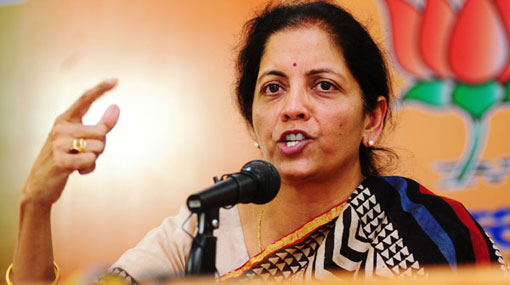
Indian Union Minister of State for Commerce and Industry, Nirmala Sitharaman, was recently in Sri Lanka to discuss the intricacies of the agreement. Image courtesy Ada Derana
Indecent hurry?
Bilateral trade agreements often take years to finalise. There appears to be an almost indecent hurry on the part of the Government to get ETCA pushed through ‒ which makes one wonder whether enough discussions have been held with all stakeholders before going ahead with signing the agreement.
Abeysinghe disagrees.
“It is quite normal for respective governments to set early deadlines. Again, Sri Lanka is not an exception. It is common to find politicians in other countries also saying, we plan to conclude the agreement with X and Y country before the end of this period etc. But experience has been that actual negotiations take much longer and it is normal to find most countries missing several set deadlines before reaching the final deal,” she said.
Wijesinha is of the same opinion.
“It is one year since the Government first told us (the various business Chambers) that it is beginning talks on an ETCA, and shared with us initial outlines. Since then we have had extensive discussions with the ministry of Development Strategies and International Trade, and the representatives of the Agency for International Trade, who are leading the negotiations on all new agreements including the ETCA. We were given drafts of the agreement, and given time to submit and discuss our detailed comments,” he said.
Could Be Better
Wijesinha would like to see more consultations ‒ well-organised, well-prepared, well-structured consultations.
“This seems to be lacking. In agreements like this, there are various factions that have to be managed and their legitimate concerns, heard. I have also seen so many mixed messages, especially on timelines. One Minister says one thing, the Prime Minister says another, and officials in the Agency for International Trade assure us of another. This is problematic, and must be fixed,” he said.
“My concern is that after not having done any real trade agreements in nearly a decade, we are now trying to do multiple new agreements within the next year and a half. This is very ambitious. Stakeholder management and communication is key in this process. In most cases, I’ve noticed that even the most vocal critics are reasonable and constructive when presented with facts and engaged in genuinely open dialogue,” he added.
Job Security
One of the biggest concerns raised about ETCA is the fear that “cheap labour” from India will be a threat to local professionals in ICT, medical, and other technological sectors. (Click here for an article we wrote on the same early this year). This is a very understandable concern, and Abeysinghe concurs.
“Movement of people under services agreements always raise concerns and all over the world. In every country, it is normal to find respective professionals opposing liberalisation of their sectors. Generally, movement of people remains the least open in all services agreements in the world. There are many instruments, tools countries have adopted when negotiating agreements, to restrict foreign nationals from entering the country. Sri Lanka is not the first or the only country to face this situation,” she said.
This where a good analysis of costs and benefits of liberalisation has to be done to ensure that what is done is in the national interest, she added.
According to Wijesinha, the ‘Mode 4’ in services will be left unbound, meaning no sectors will be opened up to free movement of professionals. IT professionals, it seems, can breathe a sigh of relief, at least for now.
“How this all came up was because in the original ETCA draft, it mentioned IT professionals and maritime engineering professionals as sectors to be opened, but these were based on the CEPA process many years ago, when it was the sectors themselves who said that they wanted to open up to India. Of course, now the view has changed. So the Government has said that it will wait for the various industry groups to tell them which services sectors they want to open and to what extent,” explained Wijesinha.
Citing the negotiating team, Wijesinha reiterated that Modes 1, 2 and 3 will be open under the ETCA, but not Mode 4 (which is the movement of independent professionals). Modes 1,2, and 3 are already open now under Board of Investment (BOI) rules. What ETCA does, in this context, is bring in an additional framework of rules.

ETCA continues to face heavy opposition from young professionals citing fears of an “Indian takeover” of their vocations. Image courtesy lankabusinessonline.com
Love Thy Neighbour
It is no secret that Sri Lanka’s increasingly close ties with China has made India nervous. In fact, Prime Minister Wickremesinghe had to downplay Indian fears of the island nation’s military ties with China around investments in the One Belt, One Road development programme.
“There has been a lot of suspicion that there is a military element to it. But that is not there. We have told this very clearly to the Chinese and they have agreed,” Indian media quoted Wickremesinghe as saying.
Abeysinghe believes that Sri Lanka has to strike a careful balance.
“Geopolitics in the Indian Ocean always will be a key factor that governs Sri Lanka’s relationship with India and China, and it is important for Sri Lanka to be mindful of the geopolitical sensitivities. Strong economic ties with both these large emerging powerhouses in Asia is critical for Sri Lanka, especially given its strategic location and the potential it has to be an economic hub in the Indian Ocean. One cannot override the importance of carefully managing the relationship with these countries. It is important to have good ties with both countries,” she said.
Wijesinha doesn’t see a connection between India’s concerns about SL-Sino relations and bilateral trade between India and Sri Lanka.
“The fact is, this agreement with India is nothing new. It has been many years in the works. Moreover, we are also negotiating an FTA with China, which also covers goods, services, investment, and economic cooperation,” he said.
A Different Perspective
Economist Ahilan Kadirgamar who has long advocated a cautious approach to all things ETCA is wary of the debate, which he says has been reduced to either trade liberalisation with value chains resulting in export-led prosperity, or service workers from India displacing local jobs. Both the neoliberal perspective of free trade led growth and the xenophobic campaign creating fears about invading Indian workers are flawed, he told Roar.
“ETCA, much like the FTA with India, will not greatly increase exports, because our state lacks policies to promote exports in goods much less in services; credible industrial policies and state investment should precede further trade liberalisation. On the other hand, arrival of
Indian workers is also unlikely, as Mode 4 of trade in services will not be opened,” he said.
The problem, according to Kadirgamar, is not with ETCA but the broader trade liberalisation strategy of the Government with many countries. With the current global economic downturn, he says, global demand is low with falling prices, and Sri Lanka could be flooded by cheaper commodities and services.
“Harvard economist Dani Rodrik has shown that trade liberalisation affects labour not by the inflow of workers and outflow of jobs, but through the declining bargaining power of workers, reducing their wages and job security. Similarly, he claims it is not increased capital flows from abroad, but rather local investment that increases exports; contemporary foreign investments are speculative rather than productive and appreciate the local currency undermining even local investments in exports. Therefore, while trade in services and investment as with ETCA will benefit the small financial elite in Colombo, it is the workers and the broader citizenry who will be devastated,” he said.
Cause for concern, indeed. While both sides have no doubt raised legitimate arguments for and against the signing of the agreement, what is clear is that the Government, increasingly unpopular as it is with regard to its economic policy, cannot afford to be hasty in taking a decision it ‒ and the country ‒ will come to regret. It is hoped that common sense prevails and the powers-that-be consult all stakeholders before forging ahead.
Featured image courtesy indianexpress.com


